Swim watch waterproof ratings don’t indicate actual diving depths but show how much static water pressure your watch can handle in lab conditions. A 3 ATM (30m) rating only protects against splashes, while 5 ATM (50m) suits light swimming, and 10 ATM (100m) works for snorkeling. True diving requires ISO 6425 certification with 200m+ ratings. Remember that swimming creates dynamic pressure different from static testing, and you’ll need regular seal maintenance. Understanding these distinctions helps you choose the perfect watch for your aquatic adventures.
Water Resistance Fundamentals for Swim Watches
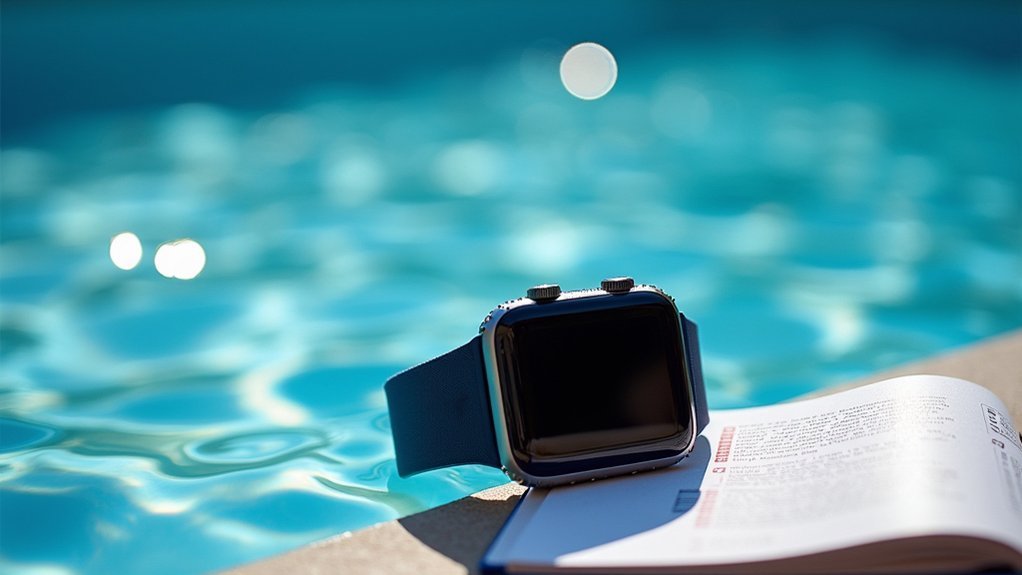
When you’re shopping for a swim watch, understanding water resistance ratings becomes essential since these numbers determine whether your timepiece can handle pool laps or ocean dives.
Water resistance indicates your watch’s ability to withstand water ingress under specific pressure conditions, typically measured in meters, atmospheres (ATM), or bars. However, these ratings reflect pressure resistance rather than actual underwater depth capabilities.
Don’t assume basic water resistance like 3 ATM or 30m protects during swimming—these ratings only guard against splashes and rain.
The numbers come from static pressure tests that don’t account for dynamic pressures you’ll create while moving through water. If your watch isn’t specifically rated for swimming or diving, never submerge it to avoid costly water damage.
Regular inspection of your watch’s water resistance features ensures optimal performance and extends its functional lifespan.
ATM Ratings and Depth Conversion Explained
How do you decode those ATM numbers on your swim watch face? ATM stands for “atmosphere,” measuring water pressure your watch can theoretically handle.
One ATM equals roughly 10 meters of static water depth—so 5 ATM converts to 50 meters, 10 ATM to 100 meters.
Here’s the catch: these aren’t actual diving depths. Manufacturers test watches under controlled lab conditions with no movement or temperature changes.
Your swimming motions create dynamic pressure that’s much different from static testing.
A 10 ATM watch works great for swimming and snorkeling but isn’t safe for scuba diving. Professional diving watches require a minimum 100-meter rating per ISO 6425 standards to be considered true dive watches.
The meter conversion helps you compare different watches, but don’t treat it as your maximum underwater depth limit.
ISO 6425 Standard for Diving Watch Certification
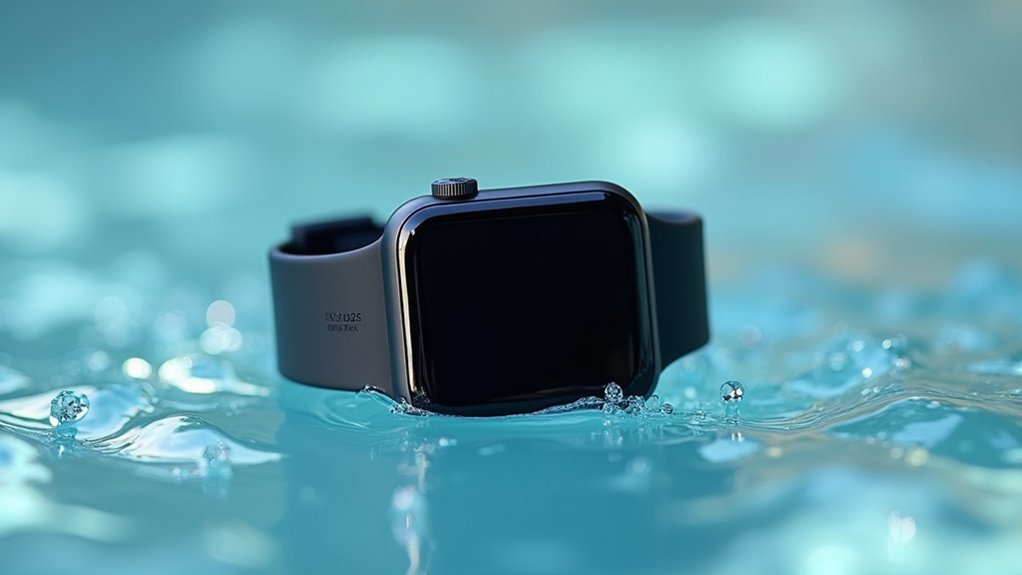
When you’re shopping for a serious swim or underwater sports watch, you’ll encounter the ISO 6425 standard—the gold standard for diving watch certification.
This rigorous certification goes far beyond basic water resistance ratings, requiring watches to pass extensive tests for thermal shock, magnetic resistance, and underwater readability.
Understanding ISO 6425 requirements helps you identify watches built for serious aquatic activities versus those with merely splash-proof capabilities. Watches that successfully pass these tests can be marked as “Diver’s” with their specific depth rating displayed on the watch face.
ISO 6425 Requirements
While general waterproof ratings provide basic guidance, the ISO 6425 standard establishes the definitive benchmark for diving watch certification. Your dive watch must achieve minimum 100-meter water resistance and withstand pressure testing at 125% of its rated depth.
You’ll need luminous markers visible from 25 centimeters in complete darkness, ensuring underwater readability. The unidirectional bezel rotates only counterclockwise, preventing accidental dive time extension that could endanger your safety.
Your watch undergoes rigorous testing including magnetic field resistance, shock resistance, and extreme temperature exposure. Timekeeping accuracy must remain within ±30 seconds daily under diving conditions.
Every component—crowns, pushers, and seals—faces durability tests preventing water ingress under pressure. The certification process requires single-watch testing rather than batch testing, which presents logistical challenges for manufacturers but ensures individual watch reliability. Only watches passing these thorough evaluations earn ISO 6425 certification, guaranteeing professional diving reliability.
Diving Watch Certification
The ISO 6425 certification represents the gold standard that separates genuine diving instruments from ordinary water-resistant timepieces. When you’re selecting a dive watch, this certification guarantees your timepiece meets rigorous safety and performance standards that could save your life underwater.
| Feature | Requirement | Purpose |
|---|---|---|
| Bezel Rotation | Unidirectional counterclockwise only | Prevents accidental dive time extension |
| Luminosity | Visible from 25cm in darkness | Guarantees underwater readability |
| Pressure Testing | 125% of rated depth | Secures reliability under extreme conditions |
You’ll find that certified watches undergo extensive testing beyond simple water resistance. They’re subjected to magnetic fields, temperature shocks, and physical impacts. The “Diver’s” label on your watchface confirms it’s passed these stringent tests, providing confidence for professional diving scenarios. The proliferation of divers watches made it difficult to identify reliable models for actual diving, which ultimately prompted the introduction of this comprehensive standard.
IP Rating System and Water Protection Levels
Understanding IP ratings is essential for selecting a swim watch that’ll actually protect against water damage. The IP code uses two digits (IPXY): the first indicates solid protection (0-6), while the second shows liquid protection (0-9).
For swimming, you’ll need at least IPX7, which protects against temporary submersion up to one meter for thirty minutes. IPX8 offers superior protection for continuous immersion at specified depths, making it ideal for serious swimmers and water sports enthusiasts.
Lower ratings like IPX4-IPX6 handle splashing and water jets but aren’t suitable for swimming.
IP68 combines dust-tight protection with prolonged water immersion capabilities, representing the gold standard for swim watches. The IP rating system follows international standards like EN 60529 to ensure consistent protection measurements across different manufacturers.
Always verify the manufacturer’s specified depth and duration limits for IPX8-rated devices.
30m Water Resistance: Basic Splash Protection
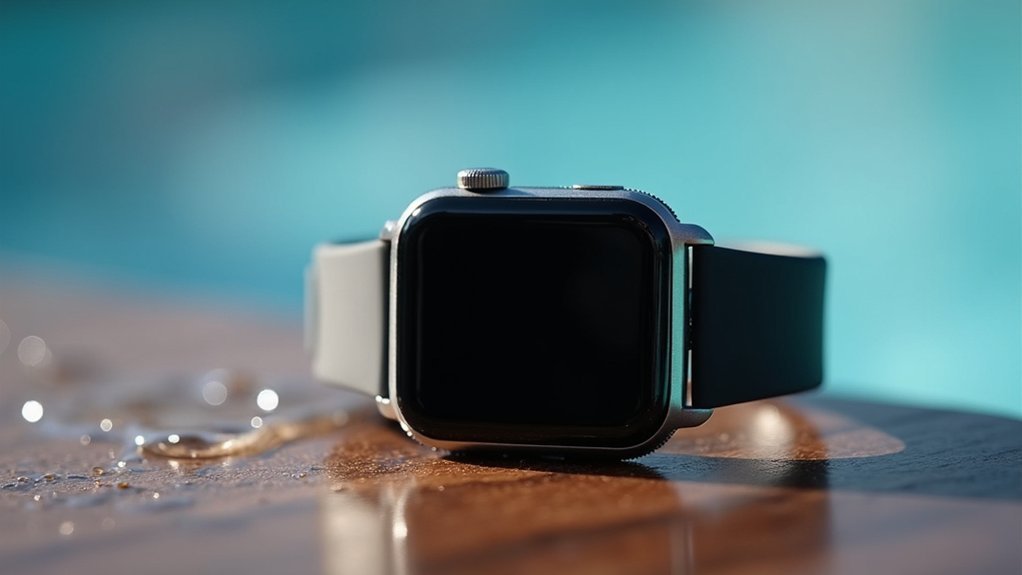
If you’re looking at a watch with 30-meter water resistance, you’re dealing with basic splash protection that’s only suitable for light water contact.
You can safely wear it while washing your hands, caught in light rain, or doing everyday tasks where minimal water exposure occurs.
However, don’t expect this rating to handle swimming, showering, or any water activities beyond accidental splashes. The depth indication doesn’t mean your watch is actually suitable for prolonged underwater use at that depth.
Light Water Contact Only
Many watches carry basic water resistance ratings that protect against light splashes but shouldn’t fool you into thinking they’re swim-ready.
These watches handle everyday water encounters like rain, sweat, or handwashing without issue. You’ll often see them labeled simply as “Water Resistant” or rated at 30 meters, but don’t mistake this for actual diving depth.
Your watch can withstand humidity and brief splashes, yet manufacturers explicitly warn against swimming, showering, or any water sports.
The 30M rating represents laboratory pressure testing, not real-world swimming conditions where wrist movement creates additional pressure.
You should avoid pressing buttons when wet and keep the crown dry.
Over time, seals deteriorate, reducing protection. Understanding water-resistance terminology becomes crucial when selecting any timepiece for your specific lifestyle needs.
Think of this rating as basic defense against life’s minor water moments, not aquatic adventures.
Hand Washing Safe Use
When you see “Water Resistant” stamped on your watch face, you’re looking at basic splash protection that’ll handle hand washing and light rain but won’t survive a swim. This 3 ATM (30-meter) rating protects against incidental moisture, not actual immersion.
Remember that ATM measurements indicate pressure resistance capabilities rather than actual depth limits, so don’t interpret these numbers as safe diving depths.
| Situation | Safe for Watch |
|---|---|
| Hand washing with soap | ✓ Yes |
| Light rain or splashes | ✓ Yes |
| Swimming or showering | ✗ No |
| Operating crown when wet | ✗ No |
| Full submersion | ✗ No |
50m Rating: Light Swimming and Water Activities
Understanding your swim watch’s “m rating” becomes essential once you decide to take it into the water for light swimming activities. The “m rating” indicates the depth in meters your watch can theoretically resist water pressure without leaking.
The m rating reveals your watch’s theoretical water resistance depth, crucial knowledge before diving into swimming activities.
A 50m (5 ATM) rating commonly allows safe submersion for light swimming and pool activities, while 30m ratings typically handle only brief water exposure.
However, you’ll need to take into account that swimming movements create dynamic pressure beyond static test conditions.
Here’s what you should know about practical limits:
- 50m rated watches handle pool swimming and shallow water activities safely
- They’re not recommended for snorkeling, diving, or high-speed water impact
- Hot tubs pose risks due to heat and pressure fluctuations
Always verify manufacturer guidelines before swimming. Consider chest strap connectivity for swimmers who need accurate heart rate data, as wrist-based sensors may lose accuracy underwater.
100m Rating: Snorkeling and Recreational Swimming
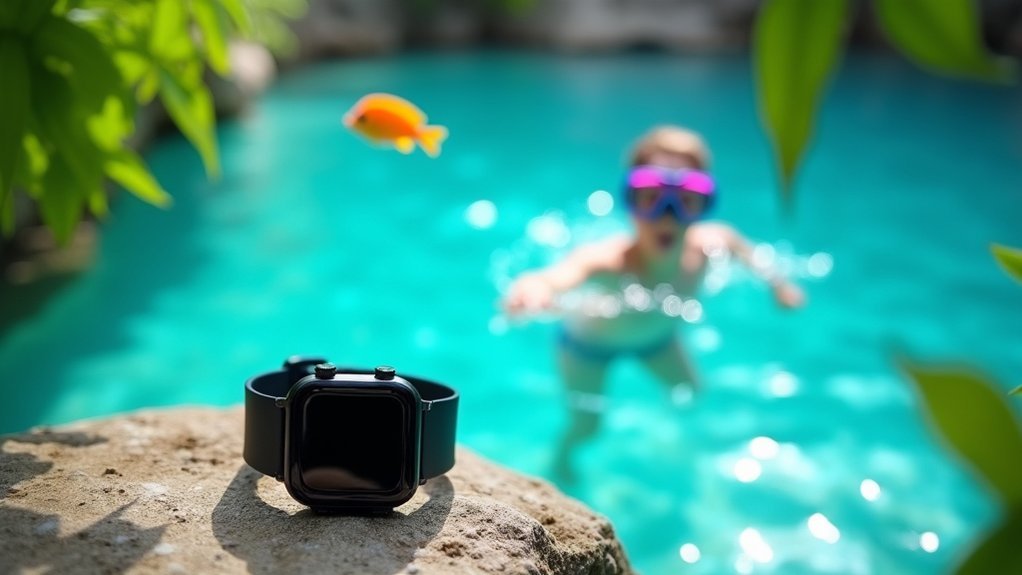
Watches with 100m (10 ATM) ratings open up considerably more aquatic possibilities than their 50m counterparts.
You’ll find these watches perfect for snorkeling adventures and recreational swimming activities. The 100m rating provides adequate safety margins for shallow-water exploration, handling varying water conditions including temperature and pressure changes you’ll encounter while snorkeling.
You can confidently wear your 100m-rated watch for swimming laps, beach activities, and even shower use without concern.
Popular models like the Garmin Fenix 8, Omega, Citizen, Seiko, and Tissot watches offer excellent water resistance at this rating level.
However, don’t exceed recommended depth limits, and remember that regular maintenance is essential. Keep in mind that dynamic pressure from real-world activities can exceed the rated pressure even at shallower depths than the watch’s rating suggests.
Check your watch’s gasket integrity periodically and follow manufacturer guidelines to guarantee long-lasting water protection for all your aquatic adventures.
200m Rating: Scuba Diving and Intensive Water Sports
Although 200m (20 ATM) ratings represent a significant leap in water resistance capability, not all watches at this level are automatically suitable for scuba diving.
Water resistance ratings alone don’t guarantee scuba diving compatibility – specialized diver certification remains essential for underwater safety.
You’ll need to look specifically for watches labeled “DIVER’S WATCH 200M” to guarantee ISO 6425 certification for underwater breathing apparatus use.
These certified diving watches offer three critical advantages:
- Underwater Operation – You can safely use pushers and crown while submerged
- Enhanced Construction – Superior sealing, anti-shock, and magnetic resistance for reliability
- Recreational Scuba Safety – Tested for depths involving air tanks (excluding helium saturation diving)
For intensive water sports like jet skiing, standard 200m watches work perfectly.
However, serious scuba diving demands that specific “DIVER’S WATCH” certification to handle the unique pressures and operational requirements of underwater exploration. After any submersion in seawater, remember to rinse your watch with plain water to remove salt and corrosive materials.
Professional Grade Ratings: 300m and Beyond
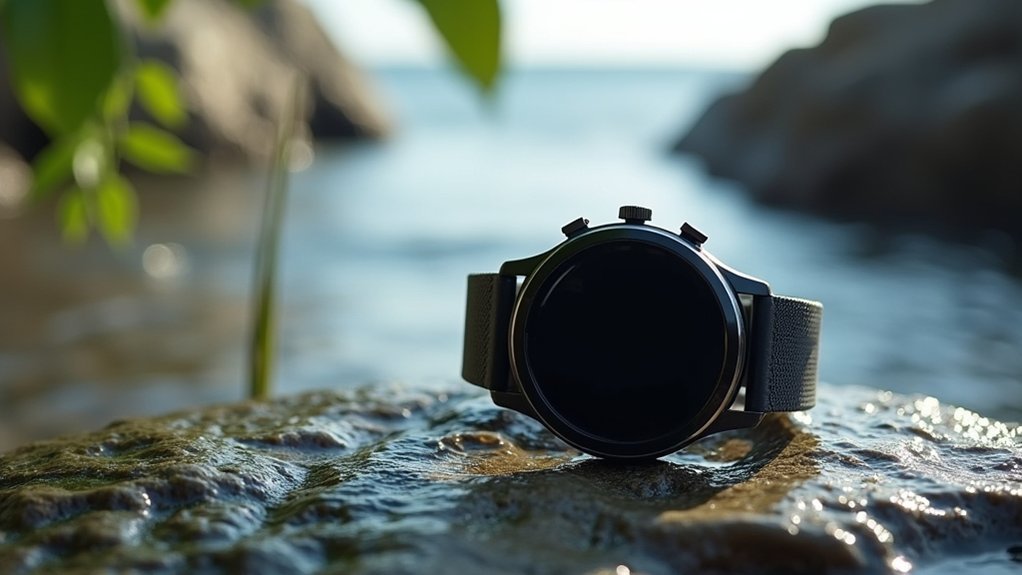
When you reach the 300m (30 ATM) threshold, you’re entering professional-grade territory where watches must meet the rigorous ISO 6425 diving standards. These timepieces feature robust stainless steel or titanium cases, sapphire crystals, and screw-down crowns with high-grade gaskets. You’ll find essential diving features like rotating bezels, luminescent markers, and helium escape valves for saturation diving.
| Feature | Purpose |
|---|---|
| Ceramic Bezels | Scratch resistance in harsh environments |
| Helium Escape Valves | Safe decompression during saturation diving |
| Chronograph Functions | Precise dive duration tracking |
Professional models like the Omega Seamaster Diver 300M and Rolex Submariner exemplify this category, balancing luxury aesthetics with functional durability. The superior automatic movements in these watches provide reliable timekeeping without battery concerns during extended underwater expeditions. You can confidently use these watches for scuba diving, deep water sports, and professional underwater tasks while enjoying their premium craftsmanship.
Static Vs Dynamic Water Pressure Considerations
Understanding your watch’s depth rating requires grasping the difference between static and dynamic water pressure.
Water pressure affects your watch differently when still versus when you’re actively moving through the water.
Static pressure comes from still water at depth – what manufacturers test in controlled environments. Dynamic pressure results from your movement through water, like swimming strokes or sudden impacts.
Here’s what you need to know about dynamic pressure’s impact:
- Minimal effect during normal swimming – arm movements at 3 feet per second add only 0.04% additional pressure at 100 meters depth
- Extreme speeds remain manageable – even 20 feet per second movement adds less than 2% pressure increase
- Static ratings include safety margins – manufacturers account for typical dynamic forces in their depth ratings
You don’t need to worry about dynamic pressure during regular swimming since it’s negligible compared to static depth pressure. Even a professional boxer’s punch underwater only generates 10 meters of additional dynamic pressure, demonstrating how minimal the impact truly is.
Maintaining Water Resistance Over Time
Your watch’s water resistance isn’t permanent and requires ongoing attention to maintain its protective capabilities.
You’ll need to inspect seals regularly for wear or damage, avoid sudden temperature changes that can compromise gasket integrity, and establish a professional service schedule for annual testing.
Replace gaskets as needed to ensure your watch maintains its rated water resistance level over time.
These proactive steps guarantee your timepiece continues protecting against water damage throughout its lifespan.
Regular Seal Inspection
Although your waterproof watch may function flawlessly for years, its seals gradually deteriorate through normal wear and environmental exposure.
You’ll need annual professional inspections to maintain peak water resistance, though frequent swimmers and divers should consider more frequent checks.
Crown and pusher seals face the greatest vulnerability due to constant movement and operation.
Your case-back gasket also degrades from repeated opening, while exposure to saltwater or chlorine accelerates deterioration across all seal points. Avoid wearing your watch in warm water environments like hot tubs, as heat can damage sealing components and compromise water resistance.
Professional inspections involve three critical steps:
- Pressure and vacuum testing to verify seal integrity
- Visual inspection for dirt, debris, or deformities
- Gasket replacement when wear is detected
Neglecting seal maintenance leads to water ingress, internal corrosion, and costly repairs that often void your warranty.
Temperature Change Precautions
While professional seal maintenance keeps your watch watertight, temperature changes pose an equally serious threat to water resistance that you can control through proper habits.
Hot water from showers and hot tubs expands gasket materials, while sudden temperature shifts stress seals and risk displacement. Chronic heat exposure dries out rubber gaskets, making them brittle over time.
You’ll want to avoid submersion in water above 40°C, as standard testing occurs between 18-25°C. Cold water below 10°C stiffens seals, reducing their flexibility.
Never move your watch rapidly from hot to cold environments, as thermal shock can create micro-tears in gaskets or trap moisture inside. Rapid pressure changes can also stress gaskets to the point of rupture, compromising your watch’s water resistance entirely.
Store your watch away from direct heat sources and allow gradual temperature adjustment before water exposure.
Professional Service Schedule
Beyond temperature management, establishing a consistent professional service schedule forms the backbone of long-term water resistance protection.
You’ll need water resistance testing every 1-2 years, with more frequent checks if you regularly swim or dive. Professional watchmakers use specialized equipment to verify your watch’s integrity through dry or wet pressure testing.
During service, technicians inspect and replace gaskets—your watch’s primary waterproof barrier. These seals naturally degrade from water exposure, chemicals, and temperature fluctuations. Controlled conditions ensure accurate testing that simulates the actual depths and pressures your watch will encounter.
Here’s what you should prioritize:
- Annual testing for heavy water use
- Gasket replacement when wear appears
- Battery service checks for quartz watches
Don’t rely on self-assessment. Professional testing prevents unexpected leaks that could damage your watch during swimming or diving activities.
Button Operation and Underwater Use Guidelines
When you’re wearing your swim watch underwater, pressing buttons can compromise the water-resistant seals that protect the internal mechanisms from damage. Most standard waterproof watches discourage button operation while submerged, as this creates potential entry points for water ingress.
| Watch Type | Button Operation | Crown Operation |
|---|---|---|
| Standard Water-Resistant | Avoid underwater | Never underwater |
| Dive Watches (200m+) | Limited use allowed | Screw-down only |
| Specialized Models | Check manual | Generally prohibited |
You should always verify your specific model’s guidelines before using buttons underwater. However, pressing buttons underwater may void the warranty even on water-resistant models, as manufacturers typically hold users responsible for water damage caused by underwater button operation. Confirm screw-down crowns are fully secured before submersion. After saltwater exposure, rinse your watch with fresh water to prevent corrosion. Regular seal maintenance every 1-2 years keeps your water resistance effective.
Choosing the Right Rating for Your Swimming Needs
Understanding these operational guidelines helps inform your next decision: selecting the appropriate waterproof rating for your specific swimming activities.
Your choice should directly correlate with how you’ll use the watch underwater.
Consider these three key activity levels:
- Casual swimming – 50m/5 ATM rating handles pool laps and shallow water activities
- Active water sports – 100m/10 ATM supports snorkeling and poolside diving
- Intensive diving – 200m/20 ATM accommodates recreational scuba diving and high-impact activities
You’ll want at least 5 ATM for versatile swimming use, but don’t assume all smartwatches perform equally at their rated depths. Waterproof ratings can vary significantly between different watch models and manufacturers.
Verify manufacturer specifications since ratings can degrade over time through normal wear.
Match your watch’s capabilities to your swimming intensity for reliable underwater performance.
Frequently Asked Questions
Can I Shower With My Swim Watch on Daily?
You shouldn’t shower daily with most swim watches. Hot water, soap, and steam can damage seals over time. Only watches rated 100m+ with proper crowns are designed for regular shower exposure.
Do Water Resistance Ratings Decrease as the Watch Ages?
Yes, your watch’s water resistance decreases over time. Seals and gaskets naturally degrade, harden, and crack with age. You’ll need regular professional servicing to replace worn components and maintain your watch’s original waterproof rating.
What Happens if Water Enters My Watch Accidentally?
Water entering your watch can short-circuit electronics, corrode metal parts, and compromise timekeeping accuracy. You’ll need to remove it immediately, dry thoroughly without heat, and consider professional servicing to prevent permanent damage.
Are Saltwater and Chlorine More Damaging Than Fresh Water?
Yes, saltwater and chlorine are considerably more damaging than fresh water. They’ll corrode metals, weaken rubber seals, and accelerate your watch’s deterioration. You should always rinse immediately after exposure to minimize damage.
Can I Get My Watch’s Water Resistance Tested Professionally?
You can get your watch’s water resistance tested professionally using specialized equipment like pressure testers and vacuum chambers. Watch repair shops and authorized dealers offer these services to validate your timepiece’s waterproof capabilities.
In Summary
You’ve now got the knowledge to make smart decisions about swim watch water resistance. Remember that ratings indicate maximum tested depths, not recommended swimming depths. You’ll want at least 100m rating for serious swimming, and you should avoid pressing buttons underwater unless specifically designed for it. Don’t forget to maintain seals and gaskets regularly. Choose a rating that exceeds your actual swimming depths for reliable protection.

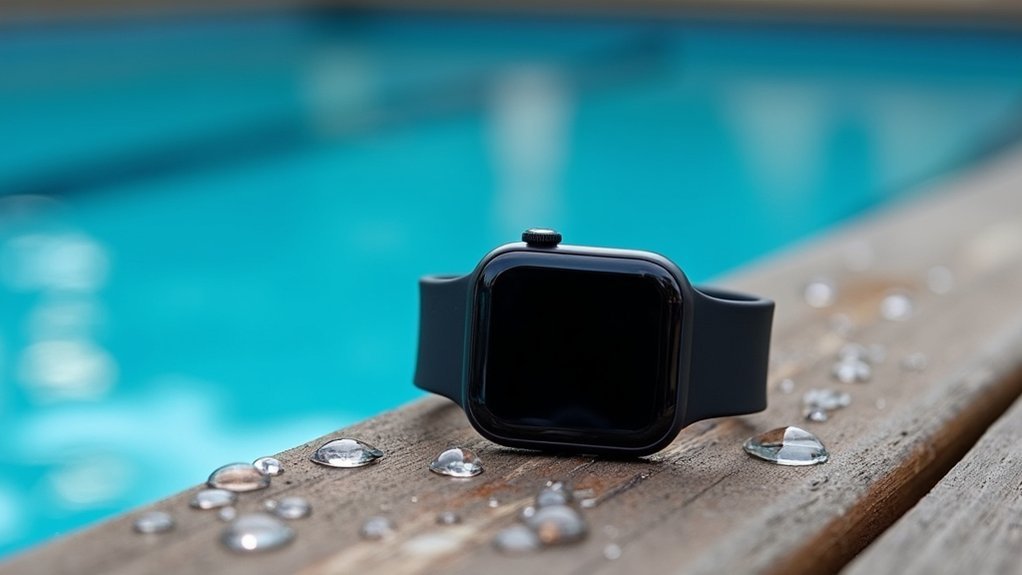



Leave a Reply